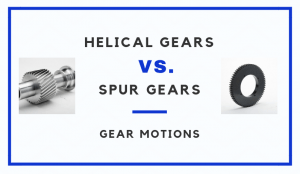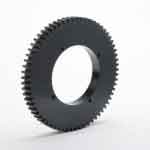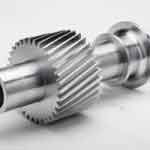Spur gears and helical gears are two of the most common types of gears. They can often be used for the same types of applications; so what are the differences between helical gears vs. spur gears?

 Spur gears are the most common type of gear, and are also the most simple. They have straight teeth that are produced parallel to the axis of the gear. Since they have the simplest design, they are the easiest to design and manufacture, and are therefore the most economical type of gear. Spur gears are not known to be the smoothest or quietest gears, but they are highly efficient and produce a lot of power. They run well at slow to moderate speeds, but they tend to vibrate and become noisy at higher speeds.
Spur gears are the most common type of gear, and are also the most simple. They have straight teeth that are produced parallel to the axis of the gear. Since they have the simplest design, they are the easiest to design and manufacture, and are therefore the most economical type of gear. Spur gears are not known to be the smoothest or quietest gears, but they are highly efficient and produce a lot of power. They run well at slow to moderate speeds, but they tend to vibrate and become noisy at higher speeds.
 Helical Gears have teeth that are set on an angle to the gear axis. Since the teeth engage more gradually, they have a smoother and quieter operation than spur gears. Helical gears also have greater tooth strength and a higher load carrying capacity. Further, helical gears can transmit power between either parallel or non-parallel shafts, while spur gears can only transfer power between parallel shafts. A downside to helical gears is they produce an axial thrust that needs to be accounted for; something not needed with spur gears.
Helical Gears have teeth that are set on an angle to the gear axis. Since the teeth engage more gradually, they have a smoother and quieter operation than spur gears. Helical gears also have greater tooth strength and a higher load carrying capacity. Further, helical gears can transmit power between either parallel or non-parallel shafts, while spur gears can only transfer power between parallel shafts. A downside to helical gears is they produce an axial thrust that needs to be accounted for; something not needed with spur gears.
So there you have it, those are the main differences between helical gears and spur gears. Still not sure the best type of gear to use for your next project? Ask the experts! With over 100 years of experience, China Gear Motions has extensive engineering and manufacturing capabilities and can provide unique solutions to your gear manufacturing problems.






